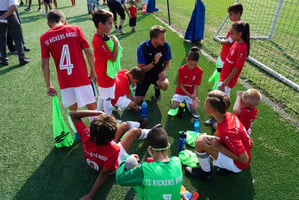Every children's coach asks themselves how they can support players in training and lead them in...
Creative 1-on-1 training with children
Children can give free rein to their creativity in 1 vs. 1 games. In direct duels, they playfully improve their technique, speed and decision-making on the pitch.

The 1 vs. 1 as the nucleus of football
One-on-one is often described as the nucleus of football. It is the smallest possible form of play, the most intense duel and can be practiced anywhere - in the school playground, on the football pitch and with your best friend in the garden. In training with children, 1 v 1 games are often given too little time, with passing drills and tactics training dominating. Winning a one-on-one duel usually makes the difference and decides whether the defensive chain is overcome, the striker is first to the ball or the defender can win the ball. For children who are reserved in duels, many 1-on-1 situations help to reduce their fears. The best creative dribblers in the world are the greatest role models for children and motivate them to emulate them and acquire their skills themselves. The coach can use such role models to work out their strengths with the children and create a list of feints together.
Ensure creative freedom in 1 vs. 1 games
To encourage children's creativity in 1v1, a natural freedom of choice is required. Coaches should coach as cautiously as possible, create exciting playing environments and allow the children to freely try out overcoming opponents. The pitches for 1 v 1 should be small and the shape, number and size of the goals should be varied. In line with the differentiated learning method, different balls can be used for 1 vs. 1 training - from tennis balls to reflex balls. Small competitions and one-on-one tournaments with opponents that are as homogeneous as possible are ideal for improving tackling skills. In this way, new game situations constantly arise for the children under high pressure from opponents, which they can solve creatively and independently - in search of the best possible way to score a goal or win the ball. Only if the children have too few experiences of success and hardly develop their own solutions should coaches support them with tips and suggestions. The aim must be to develop all types of players creatively - even those who don't like to use feints or always perform the same feint.
A training example: 1 against 1 on 4 mini goals
A simple example from training practice illustrates the advantages of a variety of one-on-one games - 1 vs. 1 on 4 mini goals. In a small field of approx. 8 x 8 meters, the attacker plays on 2 mini goals. When the ball is won, the defender counters on the other two mini goals. The game is played until a goal is scored or the ball goes out of bounds, then the next two children enter the field. The simple game is highly intensive and always offers attackers 2 targets with many offensive alternatives and defenders 2 counter-attacking options. Technical and individual tactical basics such as switching, feinting, shielding and close ball control are trained automatically and applied again and again with creative ideas. The variety of decisions in intensive 1 vs. 1 duels ensures that the children's playing experience grows and strengthens their long-term sporting training. Chaos games are another option for 1 v 1 training.
1 gegen 1 Situationen kombiniert



